International Journal of Aquaculture and Fishery Sciences
Optimization of Stocking Density for Improved Growth and Aquaculture Production of Euryhaline Tilapia, Sarotherodon melanotheron
Mbaye Tine1*, Maurice Correa1, Moussa Guèye2, Hamet Diaw Diadhiou3 and Mbacké Sembene4
1UFR of Agricultural Sciences, Aquaculture and Food Technologies (UFR S2ATA), Gaston Berger University (UGB), Route de Ngallèle BP 234 Saint-Louis, Senegal
2UFR of Agronomic Sciences, Livestock, Fisheries-Aquaculture and Nutrition (SAEPAN), University of Sine Saloum El Hadji Ibrahima NIASS (USSEIN), Senegal
3ISRA/Dakar-Thiaroye Oceanographic Research Center, BP 2241, Dakar, Senegal
4Department of Animal Biology, Faculty of Science and Technology, Cheikh Anta Diop University of Dakar (UCAD), Dakar, Senegal
Cite this as
Tine M, Correa M, Guèye M, Diadhiou HD, Sembene M. Optimization of Stocking Density for Improved Growth and Aquaculture Production of Euryhaline Tilapia, Sarotherodon melanotheron. Int J Aquac Fish Sci. 2024;10(4):038-049. Available from: 10.17352/2455-8400.000094Copyright License
© 2024 Tine M, et al. This is an open-access article distributed under the terms of the Creative Commons Attribution License, which permits unrestricted use, distribution, and reproduction in any medium, provided the original author and source are credited.The study evaluates the impact of stocking density on the growth and survival of Sarotherodon melanotheron heudelotii juveniles in seawater, focusing on their performance under different stocking densities and fertilization regimes. One hundred sixty-two (162) S. melanotheron juveniles, each weighing approximately 3 grams, were used to test the effects of different densities: D10: (10 fish/m³), D15: (15 fish/m³), D20: (20 fish/m³) and D25: (25 fish/m³). Fish were stocked in 375-liter aquaria in triplicates, with the experiment lasting for 90 days. Temperature and dissolved oxygen levels were monitored daily and the fish were fed at 5-10% of their biomass. Survival rates, weight, size, weight gain, individual daily growth, specific growth rate, and voluntary intake were compared across different densities and fertilization regimes. Lower stocking densities (D10 and D15) resulted in better growth performance, with fish exhibiting higher weight gain, size, and specific growth rates compared to higher densities (D20 and D25). The reduced growth and survival rates observed at higher stocking densities indicate that overcrowding may negatively affect the welfare of the juveniles. Tanks with fertilization demonstrated better growth performance than unfertilized tanks, suggesting that fertilization can mitigate the negative effects of higher stocking densities. Fertilization likely enhanced water quality and availability of nutrients, contributing to the overall better health and growth of the juveniles. The study underscores the importance of managing stocking density and water quality in aquaculture systems, especially in marine and estuarine environments. Lower stocking densities (≤ 20 fish/m³), combined with good water management practices (e.g., fertilization) are crucial for optimizing the growth and survival of S. melanotheron. These findings could inform best practices for aquaculture operations focusing on this species.
Introduction
The growing demand for fish has resulted in fishing pressure and a collapse of natural resources, leading to a decline in fishery catches. In 2018, global fish production reached 179 million tons, with 82 million tons from aquaculture, representing around 52% of the fish consumed globally [1,2]. Although global aquaculture has grown significantly, African countries, including Senegal, contribute relatively little to global production. Only a few countries, such as Egypt and Nigeria, dominate African aquaculture [1]. Senegal has a wealth of hydrographic resources - rivers (e.g., Senegal River), estuaries (e.g., Casamance, Sine Saloum, Gambia), and other types of freshwater bodies (e.g., Guiers Lac, Ferlo Valley), which represent significant potential to expand the sector using both intensive and extensive aquaculture techniques. However, despite these resources, Senegal’s aquaculture sector is underdeveloped, with production declines noted between 2016 and 2018.
In addition to hydrographic resources and the desire to promote aquaculture, Senegal has several species suitable for aquaculture, including Nile tilapia (Oreochromis niloticus), African catfish (Clarias gariepinus), and blackened tilapia (Sarotherodon melanotheron) [3,4]. O. niloticus and C. gariepinus are well-suited to freshwater, but they are not adapted to estuarine conditions. S. melanotheron spends much of its life cycle in estuaries, where it can benefit from the mix of freshwater and seawater [5]. Its presence in the estuaries ensures that it is well-adapted to the fluctuations in physicochemical factors that typically occur in such environments. Thus, it has been reported that the species has a high tolerance for variations in environmental parameters such as temperature [6] salinity, dissolved oxygen levels [7,8] and pH [9-11] and thrive in challenging conditions [12]. While S. melanotheron might not exhibit the same rapid potential growth as other commonly farmed species, this resilience makes it a reliable species for aquaculture, especially in areas where conditions can change rapidly.
Local farms such as Ndangane Sambou farm, located in the Fatick region of Senegal, are experiencing challenges in S. melanotheron farming, such as long production cycles and small fish sizes, which limit profitability. This study aims to support this farm by understanding the factors affecting the growth of S. melanotheron juveniles. It focuses on evaluating how different stocking densities affect growth and environmental parameters like temperature and dissolved oxygen content, but also on investigating how temperature and dissolved oxygen levels influence fish growth and whether managing these can improve production. The results of this study will provide insights into optimizing stocking density and managing environmental conditions, which could directly improve fish growth and farm profitability. By addressing the challenges faced by the Ndangane Sambou farm, the study could contribute to the development of Senegal’s aquaculture sector, benefiting the local economy and increasing the supply of animal protein.
Materials and methods
Presentation of the Bel Air fish farm
The Bel Air fish farm, nested within the IRD/CRODT-ISRA center stands as a beacon of innovation and the well-being and growth of its aquatic inhabitants. At the heart of this farm, lies a greenhouse teemed with various aquaculture facilities, each meticulously crafted to cater to different stages of fish development. The intricate design and diverse circuits (Figure 1) that make up this thriving ecosystem are:
- Broodstock conditioning (Circuit A): Comprising four 3000-litter tanks, this circuit serves as the starting point for the fish life cycle. Here, broodstock is meticulously conditioned, ensuring optimal health and reproductive capabilities.
- Fry pre-pregnancy to juvenile Stage (Circuit B): Six 225-liter aquariums form the backbone of this circuit, nurturing from their earliest stages to the juvenile phase. Careful attention is paid to their growth and development to prepare them for the next stage.
- Juvenile growth-out (Circuit C): Twelve 375-liter aquariums house juveniles in this circuit, providing ample space for growth and ensuring they reach their potential before progressing further.
- Mass magnification and reproduction (Circuit D): This crucial circuit consists of five 1000-liter tanks dedicated to mass magnification of fry and facilitating the reproduction process. It serves as a vital link in sustaining the fish population within the farm.
- Hatching (Circuit C): The incubator, equipped with six places for Joug bottles and two 225-liter aquariums, serves as the hatching ground for the next generation of fish, ensuring a continuous cycle of life within the farm.
- Quarantine (Isolated tank): A standalone 1000-liter tank provides a quarantine space for contaminated individuals, allowing for necessary treatments without jeopardizing the health of the other aquatic residents.
To ensure the well-being of its inhabitants, the entire facility is equipped with two air compressors that provide essential dissolved oxygen. While a smaller compressor caters to the needs of the incubator and Circuit A tanks, a larger one encompasses the entire greenhouse, supplying oxygen to all circuits except Circuit O.
Broodstock conditioning and reproduction
This study did not require the sacrificing of fish, and therefore no approval of ethical requirements was necessary. All steps in the experiment were carried out with respect for animal welfare. The broodstock, sourced from the Ndangane Sambou aquaculture farm (Supplementary Figure S1), is carefully harvested using shrimp fishing nets. After collection, the fish are placed in transport tanks filled with pond water, and ice packs are used to lower the water temperature. This cooling process slows down the fish’s metabolism, ensuring that the broodstock arrives at the Bel Air center in optimal condition. To ensure sufficient oxygenation of the transport container, an aerator plugged into the car battery and connected to bubblers was used throughout the fish transport period, which lasted 4 hours. This journey was marked by stops along the way to check on the conditions of the fish and also to compensate for water losses by adding a certain volume to the transport container.
Once at the Bel Air center, the broodstock undergoes acclimatization in freshwater tanks, where they are kept fasting until the following day. This fasting period ensures that the fish fully adjust to their new environment before any further handling. The broodstock is then conditioned for reproduction, with a balanced sex ratio of 1:1 maintained in two 3000-liter tanks. Daily feeding is provided with imported pelleted feed, specifically T-TILAPIA EXTRA-flot 4, to meet their nutritional needs and support reproductive health.
A weekly check, following the guidelines of Dugué, et al. (2014), is conducted to monitor the broodstock for the presence of eggs and/or larvae in their oral cavities. This allows for the collection of eggs for incubation and larvae for development. Eggs are carefully placed in an incubator to hatch, while larvae are transferred to small containers until their yolk sac is completely absorbed. Afterward, they are moved to 225-liter aquaria to continue their post-larval development under optimal conditions for growth. At around 3 grams in weight, the fry undergoes a selection process to ensure only the best specimens are used in experiments. The selected fry was gradually acclimatized to salt water by raising the salinity increment by 5ppt until it reached the seawater level (35ppt). To obtain the required salinity, the seawater was diluted with freshwater. After dilution, the level of salinity was measured using a salinometer and adjusted if necessary by adding either seawater or freshwater.
Experiment set-up
The experiment at Bel Air fish farm involved the use of 162 fry of S. melanotheron heudelotii, each with an average weight of 3 grams, for a 90-day study. Four stocking densities were tested: 10, 15, 20, and 25 fry per square meter, corresponding to D10, D15, D20, and D25, respectively. Each density was tested in triplicate, using a total of twelve 375-liter aquaria located in Circuit C of the facility (Figure 1). Seawater for the aquaria was sourced from the ocean near the Ouakam district of Dakar, transported via a motor-driven pump (Supplementary Figure S2), and stored in a 10,000-liter tank at the Bel Air farm. Water renewal in the aquaria was managed by the CRODT service car to ensure water quality throughout the experiment.
The experiment was carried out at ambient temperature with a normal photoperiod. However, all aquaria were housed in the same greenhouse, maintaining consistent environmental factors such as temperature, air humidity, and solar radiation. An oxygenation system comprising bubblers connected to an aerator was used to enrich the aquaria with oxygen. Since the experiment was carried out in a closed circuit, equipped with mechanical and biological filters, the levels of nitrite, nitrate, and ammonia are unlikely to be high and were therefore not measured.
The experimental units were randomized to minimize bias, with the allocation of treatments in the aquaria done using Excel’s ALEA function (Table 1, Figure 1). However, some tanks were exposed to sunlight due to the deterioration of the greenhouse roof (Supplementary Figure S3). This exposure allows us to test the effects of sunlight on the development of phytoplankton in the affected aquaria and their fertilization. These tanks, referred to as “green water” or “fertilized” tanks, had different water conditions compared to the “clear water” or “unfertilized” tanks, which were not exposed to the sun. The type of fertilization regime was considered during data analysis to understand its impact on growth parameters.
Feeding and maintenance
The fry was fed a complete industrial feed, T-TILAPIA EXTRA-flot 3, sourced from Gouessant Aquaculture. During the first month of the experiment, the fry was fed at a rate of 10% of their biomass, with feed distributed three times daily (9 am, 1 pm, and 3 pm), following recommendations from El-Sayed and Kawanna (2004). After the first month, the feeding rate was reduced to 5% of their biomass and maintained at this level until the end of the experiment.
Regular siphoning of the aquaria was conducted to remove feces and debris to maintain water quality and prevent the buildup of nitrogenous wastes. The siphoned water was decanted before being reintroduced into the aquaria. Monthly measurements of the fry’s weight and size were also taken to monitor their growth and development (Supplementary Figure S4).
Measurement of physicochemical and growth parameters
The monitoring of physico-chemical parameters and the assessment of growth parameters are critical for understanding how environmental factors influence the development of fish. Both temperature and dissolved oxygen levels were measured daily (Supplementary Figure S5), with particular attention to two distinct periods: the warm period and the cool period. These measurements are essential for ensuring optimal conditions for fish growth and health.
To evaluate the growth of the fish, various zootechnical parameters were assessed, primarily based on weight and size measurements. These parameters provide insights into how the fish are responding to the environmental conditions and stocking densities.
- Weight Gain (WG): WG is one of the most crucial parameters for assessing growth, which reflects the increase in body mass over a specified period. It is calculated using the formula:
WG(g) = FW(g) − IW(g)
Where:
- FW (Final Weight): The weight of the individual fish at the end of the experimental period.
- IW (Initial Weight): The weight of the individual fish at the beginning of the experimental period.
- Individual Daily Growth (IDG) / Daily Weight Gain (DWG): The IDG is calculated to assess how much weight the fish gain on average per day. This parameter is calculated using the formula:
Where,
- FW = Final weight (g)
- IW = Initial weight (g)
- T = Duration of experiment (Number of days the experiment lasted)
• Specific Growth Rate (SGR): the SGR measures the percentage growth of the fish per day. The formula for SGR is:
Where,
FW = Final weight (g)
IW = Initial weight (g)
T = Duration of the experimental period (in days)
Voluntary intake of feed (VI):
The voluntary intake of feed (VI), expressed as a percentage per day, was calculated using the following formula:
Where,
D = Total amount of feed consumed in grams (g)
Bi = Initial body weight of the fish
Bf = final body weight of the fish
DR (d): duration of feeding period (in days)
• The survival rate of the fish as a percentage was calculated as follows:
Where,
FNF: Final number of the fish; INF: Initial number of the fish
The weight-size relationship and the condition factor are crucial for understanding the growth and health of fish in aquaculture. The weight-size relationship [13] is expressed by the following formula:
Where,
Pt: total weight of the fish in g; Lt: total length of the fish in cm; a: Constant and b: coefficient of allometry or slope of the regression line varies between 2 and 4 but is typically close to 3.
If b = 3, the growth is isometric i.e. the fish grows in both size and weight;
If b ≠ 3 the growth is allometric, meaning the fish grows in both size and weight.
If b < 3, the fish grows more in size than in weight.
If b > 3, the fish grows more in weight than in size.
• The parameters (a) and (b)are estimated using linear regression:
The condition factor K or condition coefficient K expressed in g/cm3 is a measure to assess the overall health and well-being of fish populations. It is calculated as the ratio between the weight and the size of the fish. The K was calculated as follows:
Where,
Pt is the total weight of the fish in g; L is the total length of the fish in cm.
The classification of fish into groups based on their condition factor (K) can provide valuable insights into their health and condition. The method that involves calculating class ranges using Sturges (1926) rule is a common technique for grouping data into intervals or classes for analysis. Once these classes are determined, they can be interpreted according to the guidelines provided by Fournier [14] to understand the conditions of fish populations. Sturges’ rule is a simple formula used to determine the number of classes (or intervals) grouping data in a histogram or frequency distribution. The formula is:
Where,
k is the number of classes and n is the number of observations (number of fish)
If K > 1.60: Excellent rearing conditions.
If K = 1.40: Good rearing conditions.
If K = 1.20: Acceptable farming conditions.
If K ≤ 0.80: Worse farming conditions.
Statistical analysis
A comprehensive statistical analysis of the data was conducted. First, the normality testing with Shapiro-Wilk was conducted to check if data are normally distributed. Thus, we found that the distribution of data was not normal for all the parameters except for fish size. Krustal Wallis test was therefore used for parameters with non-normally distributed data to check for significant differences between treatments (densities). Bonferroni multiple comparison test was then applied to compare the medians of parameters between the four densities (D10, D15, D20, and D25) to detect significant differences.
Levene’s test for homogeneity of variances was used for fish size, which showed homogeneity of variances. Two-factor analysis of variance (ANOVA) was used to determine the influence of stocking density and tank fertilization on fish size. ANOVA was used to compare mean sizes between densities for fertilized tanks and unfertilized tanks.
Spearman’s correlation test was used to assess relationships between physicochemical parameters (temperature, dissolved oxygen) and between these parameters and stocking density. This test was also used to assess the overall variation in weight and size as a function of density and to evaluate the size-weight relationship. It was also used to assess food consumption by fish (VI) as a function of temperature and dissolved oxygen concentration in water.
All tests were run on R statistical software version 4.0.4 and R Studio version 1.4.1106. A significance level set at α = 0.05 was used for all tests.
Results
Physicochemical parameters
Temperature and dissolved oxygen data were found to not follow a normal distribution, as indicated by the Shapiro-Wilk test (p - value < 0.05). Therefore, non-parametric tests were used for analysis. Significant differences in water temperature were observed between densities, with D25 having significantly higher temperatures compared to D10, D15, and D20 (Figure 2, Supplementary Table S1). The overall temperature variation ranged from 29.80 ± 0.31 °C and 23.24 ± 0.23 °C during the experiment with an average of 27.77 ± 2.78 °C (Supplementary Table S1).
There were significant differences in dissolved oxygen levels between densities, with the lowest densities (D10, D15, and D20) having higher levels compared to D25 (Figure 2, Supplementary Table S1). The overall range of dissolved oxygen levels was from 4.33 ± 0.39mg/l to 3.47 ± 0.34mg/l with an average of 3.73 ± 0.45 mg/l (Supplementary Table S1).
Both temperature and dissolved oxygen levels varied over time. For temperature, it ranged from 29.69 ± 0.43 to 29.97 ± 0.18 °C during the first month and from 22.99 ± 0.10 to 23.38 ± 0.12 °C during the last month of the experiment (Figure 2, Supplementary Table S1). For dissolved oxygen, levels ranged from 2.90 ± 0.54 to 3.77 ± 0.19 mg/l during the first month and from 4.22 ± 0.58 to 4.49 ± 0.56 mg/l during the last month of the experiment (Supplementary Table S1).
The comparison between the beginning and the end of the experiment revealed that dissolved oxygen concentration was lower during the first month, indicating temporal variations in this parameter.
The analysis of the relationship between temperature, stocking density, and dissolved oxygen concentration reveals several key findings. Indeed, there is a positive correlation between temperature and stocking density (Figure 3). As stocking density increases, temperature tends to increase as well. This correlation while weak, is statically significant (Spearman’s correlation; R = 0.24; p < 0.0001).
Conversely, dissolved oxygen concentration decreases as stocking density increases (Figure 3). This negative correlation is also statistically significant, indicating that higher stocking densities are associated with lower dissolved oxygen levels (Spearman’s correlation; R = -0.37; p < 3.557e-10).
Furthermore, there is a significant negative correlation between temperature and dissolved oxygen concentration. As temperature increases, dissolved oxygen tends to decrease, and vice versa. This negative relationship is robust and highly significant (Spearman correlation; R = - 0.67; p < 2.2e-16).
Zootechnical parameters
Survival rate: The zootechnical parameter analyzed in this section is the survival rate of the experimental units. The Shapiro-Wilks normality test revealed that the survival data did not follow a normal distribution (p - value < 0.05), indicating non-normality in the dataset. To compare the survival rates among the four densities, a non-parametric approach, specifically the Krustal Wallis test, was used. The results showed a significant difference between the densities (p - value < 2.2e-16). The survival rates ranged from 87.50 to 83.33% for D10, 91.67% to 88.89% for D15, 86.67% to 66.67% for D20, and 98.25% to 61.40% for D25 (Table 2). The average survival rate for D10, D15, D20, and D25 was 86.11 ± 2.41%, 89.82 ± 1.60%, 79.26 ± 10.96%, and 85.38 ± 20.78%, respectively (Table 2). A Bonferroni test was conducted to identify significant differences between the densities. It was found that the survival rates differed significantly among the densities (p - < 0.05). Specifically, the survival rates were higher for D10 and D15 and lower for D20 and D25 (Bonferroni Test; p - value < 0.05).
Growth parameters: The exposure of some experimental units to the sun due to greenhouse roof deterioration has led to different water conditions in the aquariums – green water for exposed tanks (fertilized) and clear water for sheltered tanks (unfertilized). Tank fertilization was, therefore, considered to better understand and interpret the observed variations in growth parameters. This allows us to ensure that any effects attributed to stoking densities or other factors, such as temperature, and dissolved oxygen, are accurately assessed relative to the tank’s nutrient levels.
Comparison of the medians of the weight averages showed that they were significantly different between densities. Average weights during the experiment ranged from 12.17 ± 1.41g for D10 to 9.59 ± 0.64 g for D25 (Supplementary Table S2). Both stocking density and water types (fertilization) separately influenced fish weight. Fish weight was lower for D25 compared to other densities. In clear water (unfertilized tanks), D10 and D20 had significantly higher weights compared to D15 and D25 (Figure 4, Supplementary Table S2). However, in green water (fertilized tanks), average weights did not significantly differ between densities, with generally higher weights observed in fertilized tanks.
Size data distribution was normal, and homogeneity of variance was verified. Two-factor ANOVA was used to compare mean sizes, with average sizes ranging from 8.70 ± 0.46, for D10 to 8.10 ± 0.27 for D25 (Figure 5, Supplementary Table S2). In clean water (fertilized tanks), D10 and D20 had the best sizes, while D25 had the lowest average size (Figure 5). In green water, sizes did not significantly differ between densities but were generally higher than in clean water (Figure 5). Significant effects of both factors density and water type) were observed on fish size, particularly pronounced for D25.
Weight and size showed negative correlations with density, albeit weak but statistically significant between weight and density (Spearman’s correlation; R = - 0.30, R = - 0.27, respectively) (Figure 6).
Weight varied with size for all densities, showing a positive correlation where weight increases with size. This positive correlation was very strong and significant for all densities (Spearman correlation; R = 0.94-0.96; p < 2.2e-16) (Figure 7).
Weight Gain (WG), individual daily growth (DIG), Specific Growth Rate (SGR), Voluntary Intake (VI), allometry coefficient (b), and condition factor (K) date were also not normally distributed. WG varied across all densities. Specifically, for D10, D15, D20, and D25, the weight gain ranged from 6.62 to 0.24g, 5.85 to 0.71g, 5.78 to 0.71g, and 5.01-0.71g, respectively (Table 3). The average WG for each density were 9.18 ± 3.26g, 7.41 ± 2.98g, 9.00 ± 2.57g, and 5.84 ± 2.78g, respectively (Table 3). WG varied over the experimental period, with higher gains during the first month (war period) and lower gains during the third-month cool period).
Significant differences in individual daily growth (IDG) medians were found between the four densities (Krustal Wallis Test; p - value = 2.496e-4). Multiple comparison tests indicated that the IGR of D10, D15, and D20 were higher than that of D25 (p - value < 0.05). No significant difference was observed between D10, D15, and D20. IDG decreased over the experiment duration, with higher values in the first month and lower values in the last month, regardless of density (Table 3).
The average Specific Growth Rate (SGR) varied among densities, with values 1.34 ± 1.72, 1.22 ± 1.69, 1.36 ± 1.39, and 1.02 ± 1.53 for D10, D15, D20, and D25, respectively (Table 4). D10, D15, and D20 had higher SGR than D25. SGR also varied throughout the experiment, being higher in the first month and lower in the third month (Table 4).
The voluntary intake (VI) varied between densities, with values ranging from 1.23 ± 19%/d (D10) to 0.63 ± 0.01d (D25) (Table 4). Significant differences in VI medians were found between (Krustal Wallis Test: p - value < 2.2e-16), decreasing with density. D10 had the highest IV, while D25 had the lowest. VI tended to decrease with time for D10, D15, and D20, but increased for D25.
Food consumption (VI) by fish showed a significant positive correlation with water temperature and dissolved oxygen (Figure 8) (Spearman’s correlation; R = 0.70; p < 2.2e-16). The correlation between food consumption and dissolved oxygen was negative and significant (Spearman correlation; R = -0.61; p < 2e-16), with feed consumption in hot weather (Temperature > 28 °C) compared to cool weather (< 24 °C).
The allometry coefficient (b) ranged from 2.59 to 2.65 for all densities (Table 5) indicating allometric growth favoring size overweight. Significant differences in the medians of the (b) coefficient were observed between the four densities (Krustal Wallis Test; p - value < 2.2e-16). There was no significant difference in (b) coefficient between D15 and D20, but both were significantly higher compared to D10 and D25. Additionally, D10 has a significantly higher (b) coefficient compared to D25.
The condition factor K varied between 1.74 ± 0.16 and 1.79 ± 0.13 g/cm3 (Table 5). Significant difference in the medians of the average K for the four densities (Krustal Wallis Test; p - value = 3.833e-3). K of D10 was not significantly different from that of D25, but it was higher than that of D20. K was not different between D15 and D20.
Discussion
Understanding the intricate interplay between physiochemical parameters, welfare factors, and growth parameters in fish species is pivotal for divisive approaches to fish farming. The growth performance in aquaculture hinges on both the inherent genetic potential of the species being cultivated and the conditions under which they are reared. These conditions include myriad factors such as water physicochemical factors, stocking density, feed quantity, and feed quality [15,16]. Stocking density, in particular, exerts a significant influence on growth. It can directly impact growth rates while also exerting indirect effects through its influence on physicochemical factors like temperature, and dissolved oxygen. Additionally, stocking density plays a role in feed utilization efficiency [17]. Therefore, optimizing stocking density within aquaculture systems is crucial to achieving desired growth outcomes while maintaining the overall welfare and health of fish-cultured populations.
Physicochemical parameters
The study reveals notable findings regarding the physiochemical parameters within the aquaria and their correlations with stocking density. There is a significant increase in temperature as stocking density rises, particularly noticeable above 20 fish/m3. This increase remains in the recommended range for rearing S. melanotheron [18,19], despite variations over time and between treatments. Conversely, there is a significant decrease in dissolved oxygen content as stocking density increases. This decline is not attributed to differences in the aeration system but rather to the direct effect of stocking density on oxygen consumption or indirectly through its impacts on temperature. The study identifies a positive correlation between temperature and stocking density, confirming the influence of stocking density on water temperature. Similarly, there is a negative correlation between oxygen concentration and stocking density, as well as between oxygen content and water temperature. Throughout the experiment, water temperature ranged from 23.24 °C to 29.80 °C, falling within the optimal thermal preference for the growth of S. melanotheron [10]. The temporal variations in water temperature are attributed primarily to seasonal effects. In Senegal, the climate is characterized by two main seasons: the dry season and the rainy season [11]. The dry season, spanning from November to March, is further divided into a cool period and a hot period. Conversely, the rainy season, lasting from July to October, is characterized by hot and humid conditions. These seasonal variations likely influence the observed fluctuations in temperature through the experimental period. Likewise, dissolved oxygen concentration remained above 2.3mg/ml, a critical threshold for growth, particularly in S. melanotheron [20]. These findings underscore the intricate relationship between stocking density, physiochemical parameters, and their implications for the welfare and growth of S. melanotheron heudelotii within aquaculture systems. Moreover, they highlight the importance of carefully managing stocking density to maintain favorable environmental conditions and maximize growth performance in fish farming operations.
Zootechnical parameters
Survival rate: The study reports varying survival rates for fish maintained in seawater, ranging from 79.26% to 89.82%. These rates are higher than those observed in freshwater culture but lower than those in concrete and cage ponds [21]. Disparities in survival rates across different environments may stem from factors like salinity and water quality. High salinity can impose metabolic costs associated with osmotic regulation [22], potentially leading to lesions and increased mortality [23]. Additionally, water turbidity caused by particles or debris can obstruct fish gills, resulting in mortality, particularly in high turbid conditions [24,25].
Survival rates exhibited slight variations between stocking densities during the initial two months of the experiment. However, by the third month, the survival rate significantly declined in densities D20 and D25 compared to D10 and D15. This pattern aligns with findings in tilapia studies, indicating that higher stocking density correlates with lower survival. This negative influence of stocking density on survival rates is attributed to intense competition for food and space among fish, as well as increased biomass to heightened stress due to reduced swimming space [26,27]. These insights emphasize the importance of carefully managing stocking densities in aquaculture settings to mitigate factors contributing to decreased survival rates and optimize overall fish welfare and productivity.
Growth parameters: The highest fish weight was observed in densities D10 and D20. Specifically, D10 and D20 yielded 12.17 ± 1.41 g and 11.46 ± 1.69 g, respectively, and sizes of 8.70 ± 0.46 cm and 8.70 ± 0.53. Conversely, fish weight and size exhibit a negative correlation with stocking density, with both decreasing as density increases. This trend aligns with previous findings in Nile tilapia O. niloticus studies, where increasing stocking density led to a reduction in final weight [28,29].
While weight gain (WG) did not significantly differ between densities, individual daily growth (IDG) and specific growth rate (SGR) declined with increasing density particularly noticeable beyond 20fish/m3. Densities D10 and D20 consistently demonstrated better IDG and SGR values. The study highlights a significant decrease in WG, IDG, and SGR as water temperature declines from the warm period (month 1) to the cold period (month 3). High temperatures typically stimulate growth to some extent, as observed in previous studies [30]. The relationship between temperature and growth rates is further corroborated by studies on various fish species, indicating an optimal temperature range for growth [31-34]. These findings underscore the complex interplay between stocking density, temperature, and growth parameters in fish farming. They emphasize the importance of optimizing environmental conditions, including stocking density, and water temperature, to maximize growth performance and overall productivity.
The growth performance observed in this study at different stocking densities appears to be lower compared to previous studies conducted on the same species. For instance, Ouattara, et al. [9] conducted research on S. melanotheron in freshwater cages and observed higher daily growth rates than those found in this study. They reported or noted variations in daily growth rates across different stocking densities, suggesting an influence of stocking density on growth. Similarly, Ouattara, et al. [10] found differences in DGR among different rearing environments, indicating an influence of temperature on growth. Our study also demonstrates higher DGR during warmer periods, consistent with the impact of temperature on growth.
Furthermore, the rearing system, itself seems to affect the growth rates, particularly due to factors such as natural productivity, feeding habits, and ecological requirements of the fish. This is supported by observations of better growth in aquaria exposed to solar radiation, leading to increased phytoplankton productivity. The presence of phytoplankton in fertilized tanks likely enhances growth rates, particularly since S. melanotheron is planktivorous and relies on natural pond fertilization for its diet [35,36]. This aligns with previous findings suggesting that growth parameters and nutrient intake can be influenced by the productivity of the rearing environment [37,38]. Overall, these findings emphasize the complex interactions between stocking density, temperature, rearing environment, and natural productivity in influencing the growth performance of S. melanotheron in aquaculture settings. Understanding these dynamics is crucial for optimizing growth outcomes and maximizing the efficiency of fish farming systems.
The relationship between stocking density, food consumption, available oxygen, water temperature, and energy production in fish farming systems is indeed significant and multifaceted, as highlighted by Ellis, et al. [39] and Escudero [17]. Fish, being exothermic organisms, rely on their environment, particularly water temperature, to regulate their metabolic processes. An increase in water temperature can lead to higher oxygen consumption and accelerated metabolism in the fish. This, in turn, influences the amount of energy produced and the heat released by the fish. Escudero [17] notes that stocking density directly impacts the oxygen levels in rearing environments due to increased oxygen demand from higher fish numbers, affecting overall metabolism and energy production.
Studies have demonstrated that even modest temperature increases can significantly impact oxygen concentration in water and fish metabolism. For example, Klontz [40] found a 67.5% increase in metabolism in rainbow trout weighing 100 grams. These findings underscore the sensibility of fish to environmental changes and the intricate relationship between temperature, oxygen levels, and metabolic rate.
Furthermore, Escudero [17] suggests that as stocking density rises, the amount of food available per individual fish decreases. This reduction in food availability can result in slower growth rates due to increased competition of this resource among fish within the same environment. This study demonstrates significant differences in voluntary food intake (VI) across different stocking densities, with VI decreasing as stocking density increases. Particularly, D10 exhibits higher VI compared to D25, where high phytoplankton productivity is noted due to exposure to solar radiation. This decrease in feed utilization efficiency with increasing stocking density suggests increased stress levels among fish.
Disparities in VI between D10 with (unfertilized) and D25 (fertilized) could be attributed to the silt-grazing nature of S. melanotheron and its preference for phytoplankton [41,42]. In fertilized tanks with phytoplankton, S. malanotheron tends to consume less artificial food and more phytoplankton. This interpretation aligns with the growth results, indicating better weights and sizes in the fertilized tanks compared to unfertilized ones. Interestingly, the lack of significant differences in weight and size among densities D15, D20, and D25 in fertilized tanks suggests that the presence of phytoplankton may mitigate the effects of stocking density on fish growth. Overall, this highlights the complex interplay between stocking density, phytoplankton productivity, temperature, oxygen levels, and food consumption in influencing the growth performance of S. melanotheron in aquaculture systems. Optimizing these factors is crucial for enhancing fish welfare and maximizing productivity in fish farming operations.
The relationship between stocking density and temperature in rearing units is indeed crucial for ensuring optimal growth conditions for fish. As noted by North, et al. [43], temperature can exacerbate the negative effects of high density, while stocking density can amplify the impact of temperature on fish. High stocking densities can elevate water temperature within rearing structures. If the initial temperature is already optimal for growth, this increase can push it beyond the optimal range, leading to a slowdown in growth. Conversely, if the initial temperature is below the optimum, higher stocking densities can help bring it closer to the optimal range and maintain it there.
However, it’s important to note that high stocking densities can also result in reduced dissolved oxygen, levels in the water, which can further impact fish growth. This decrease in oxygen availability may lower the quality of dissolved oxygen accessible to fish, as highlighted by Colt and Tomasso [44]. Insufficient oxygen concentration can hinder the fish’s ability to convert energy efficiently, potentially leading to a decrease in growth rates, as noted by Jones [45]. Therefore, careful management of stocking density and monitoring water temperate and oxygen levels are essential in aquaculture systems. Managing optimal conditions for temperature and oxygen ensures that fish can thrive and grow efficiently, ultimately contributing to the success of fish farming operations.
Fish growth in aquaculture is indeed commonly assessed through changes in weight and size, reflecting the welfare of the fish within their environment [46]. The welfare of fish is influenced by various factors, including stocking density, which affects the spatial distribution of fish within the environment and can consequently impact growth [47].
Our results demonstrate that the weight-size relationship, indicated by the coefficient b, was lower in D25 compared to other densities, suggesting differences in growth patterns among stocking densities. These findings align with previous research by Ndour, et al. [48] on the same species, which highlighted the influence of environmental factors such as pond depth and size on fish growth. Shallow ponds, which warm up quickly, can induce stress and hinder fish growth, consistent with the observed differences in growth patterns across different rearing units.
Additionally, the condition factor (K), which reflects the relationship between the fish’s environment and their weight, indicates that the fish in your study were under favorable rearing conditions, with K values exceeding 1.60 [14,49]. These findings are consistent with previous studies conducted in similar environments, such as the ponds of the Bandial region of Lower Casamance [48].
The insights from this research can be applied to fish farming in ponds located in estuarine and coastal areas, helping to expand marine aquaculture in regions where freshwater fish farming currently dominates. Moreover, the fertilization and quantification of plankton productivity in rearing ponds could further optimize growth outcomes. By applying our findings to production ponds in estuarine and coastal zones, the benefits of our research could be substantial. Investigating genetic variations and growth performances across different strains of S. melanotheron hedeulotii in Senegal could lead to improved production yields, supporting the growth of a more sustainable and efficient aquaculture industry in the region.
Conclusion
The findings of this study highlight the significant impact of stocking density on key environmental factors such as water temperature, oxygen concentration, and juvenile survival. When stocking density exceeds 20 fish/m³, water temperature increases, and dissolved oxygen levels decrease, leading to higher mortality rates, especially under warmer conditions. Despite these challenges, optimal growth occurs during the warmer periods, indicating the species’ preference for specific temperature ranges.
Additionally, we found that fish growth is improved in productive rearing environments with abundant phytoplankton, which can reduce the need for artificial feed. Growth rates are notably higher in saltwater environments when temperatures are maintained between 29-30 °C. The influence of stocking density on juvenile growth is evident, with more pronounced effects observed at densities above 20 fish/m³.
These results underscore the importance of creating optimal rearing conditions for S. melanotheron hedeulotii growth. This includes maintaining stocking densities at or below 20 fish/m³, ensuring water temperatures stay within the 29-30 °C range, and promoting natural fertilization of rearing water to enhance primary productivity, particularly phytoplankton. By doing so, aquaculture farms can optimize growth outcomes and reduce reliance on external feed inputs.
The authors thank Gaston Berger University and CRODT (Oceanographic Research Center Dakar-Thiaroye) of ISRA. We also thank the Ndangane Sambou fish farm for supporting this study.
- FAO. The State of World Fisheries and Aquaculture 2022. Towards Blue Transformation. Rome: Food and Agriculture Organization of the United Nations; 2022. Available from: https://openknowledge.fao.org/items/11a4abd8-4e09-4bef-9c12-900fb4605a02
- FAO. The State of World Fisheries and Aquaculture 2020. Sustainability in Action. Rome: Food and Agriculture Organization of the United Nations; 2020. Available from: https://openknowledge.fao.org/items/b752285b-b2ac-4983-92a9-fdb24e92312b
- Baldé BS, Diadhiou HD, Thiam N, Kantoussan J, Niane A, Ndiaye W. Aquaculture in Senegal: Current state, challenges and development prospects. ISRA-BAME political notes. 2020;5.
- Diedhiou I, Diadhiou HD, Deme M. Production and consumption of aquaculture fish in Saint-Louis, Senegal. J Appl Biosci. 2020;152:10-35759/JABs.152.4.
- Gning Cissé N. Trophic ecology of juveniles of four fish species in the inverse Sine-Saloum estuary (Senegal): Influence of contrasting salinity conditions. 171;2008.
- Albaret JJ. Fish populations in Casamance (Senegal) during periods of drought. Rev Hydrobiol Trop. 1987;29:1–310. Available from: https://www.scirp.org/reference/referencespapers?referenceid=2999354
- Lemarié G, Baroiller JF, Clota F, Lazard J, Dosdat A. A simple test to estimate the salinity resistance of fish with specific application to O. niloticus and S. melanotheron. Aquaculture. 2004;240(1-4):575-587. Available from: https://doi.org/10.1016/j.aquaculture.2004.07.014
- Panfili J, Mbow A, Durand JD, Diop K, Diouf K, Thior D, et al. Influence of salinity on the life-history traits of the West African black-chinned tilapia (Sarotherodon melanotheron): Comparison between the Gambia and Saloum estuaries. Aquat Living Resour. 2004;17(1):65-74. Available from: https://www.alr-journal.org/articles/alr/pdf/2004/01/alr02.pdf
- Ouattara NI, Teugels GG, N'Douba V, Philippart JC. Aquaculture potential of the black-chinned tilapia, Sarotherodon melanotheron (Cichlidae): Comparative study of the effect of stocking density on growth performance of landlocked and natural populations under cage culture conditions in Lake Ayame (Côte d’Ivoire). Aquacult Res. 2003;34(15):1223-1229. Available from: https://doi.org/10.1046/j.1365-2109.2003.00921.x
- Ouattara NI, N'Douba V, Teugels G, Philippart J. Effects of three agricultural by-products on cage culture growth performances of a landlocked population of Sarotherodon melanotheron (Teleostei: Cichlidae) in man-made Lake Ayame, Côte d’Ivoire. Afr J Aquat Sci. 2005;30(2):125-129. Available from: https://doi.org/10.2989/16085910509503846
- Philippart JC, Ruwet JC. Ecology and Distribution of Tilapias. In: Pullin RSV, Lowe-McConnell RH, editors. The Biology and Culture of Tilapias. Manila: ICLARM; 1982;15-60.
- Ndiaye A. Responses of tilapia Sarotherodon melanotheron to multiple stresses (salinity and chemical contaminants): Multi-parametric approach. Doctoral thesis. 2012;226.
- Le Cren ED. The Length-Weight Relationship and Seasonal Cycle in Gonad Weight and Condition in the Perch (Perca fluviatilis). J Anim Ecol. 1951;20:201. Available from: https://doi.org/10.2307/1540
- Fournier J. Optimization of the formulation of a diet with reduced phosphorus content in rainbow trout (Oncorhynchus mykiss) with the aim of reducing phosphorus releases. Master's thesis, University of Laval; 2012;90.
- Boyd CE, Tucker CS. Pond Aquaculture Water Quality Management. Boston: Kluwer Academic; 1998. Available from: https://link.springer.com/book/10.1007/978-1-4615-5407-3
- Delincé G. The ecology of the fish pond ecosystem: with special reference to Africa. In: Developments in Hydrobiology. Dordrecht; Boston: Kluwer Academic Publishers; 1992. Available from: http://dx.doi.org/10.1007/978-94-017-3292-5
- Escudero M. Fish welfare in aquaculture. Veterinary doctoral thesis, Faculty of Medicine of Créteil, National Veterinary School of Alfort; 2018;66.
- Lazard J. La pisciculture des tilapias. Agriculture. 2009;18:174-182. Available from: https://doi.org/10.1684/agr.2009.0305
- Tran-Duy A, Schrama JW, Van Dam AA, Verreth JAJ. Effects of oxygen concentration and body weight on maximum feed intake, growth and hematological parameters of Nile tilapia, Oreochromis niloticus. Aquaculture. 2008;275:152-162. Available from: https://doi.org/10.1016/j.aquaculture.2007.12.024
- Ross LG. Environmental physiology and energetics. In: Beveridge MCM, McAndrew BJ, editors. Tilapias: Biology and Exploitation. Great Britain: Kluwer Academic Publishers; 2000. p. 89-128. Available from: https://link.springer.com/chapter/10.1007/978-94-011-4008-9_4
- Ouattara NI, Ndouba V, Kone T, Snoeks J, Philippart JC. Performance de croissance d’une souche isolée du tilapia estuarien Sarotherondon melanotheron (Perciformes, Cichlidae) en bassins en béton, en étangs en terre et en cages flottantes. Ann. Univ. M. NGOUABI. 2005a;1-7. Available from: https://www.africamuseum.be/publication_docs/Ouattara%20et%20al%202005%202.pdf
- El-Zaeem SY, Ahmed MMM, Salama ME-S, El-Maremie HA-R. Production of salinity tolerant Nile tilapia, Oreochromis niloticus through traditional and modern breeding methods: II. Application of genetically modified breeding by introducing foreign DNA into fish gonads. African Journal of Biotechnology. 2011;10(4):684-695. Available from: http://dx.doi.org/10.13140/2.1.4462.4007
- Lawson E, Anetekhai M. Salinity tolerance and preference of hatchery reared Nile tilapia, Oreochromis niloticus (Linnaeus 1758). Asian Journal of Agricultural Sciences. 2011;3(2):104-110. Available from: https://maxwellsci.com/print/ajas/v3-104-110.pdf
- Martins CIM, Ochola D, Ende SS-W, Eding EH, Verreth JAJ. Is growth retardation present in Nile tilapia Oreochromis niloticus cultured in low water exchange recirculating aquaculture systems? Aquaculture. 2009;298:43-50. Available from: https://doi.org/10.1016/j.aquaculture.2009.09.030
- Santos GA, Schrama JW, Mamauag REP, Rombout JHWM, Verreth JAJ. Chronic stress impairs performance, energy metabolism and welfare indicators in European seabass (Dicentrarchus labrax): The combined effects of fish crowding and water quality deterioration. Aquaculture. 2010;299:73-80. Available from: https://doi.org/10.1016/j.aquaculture.2009.11.018
- Keeley ER. An experimental analysis of territory size in juvenile steelhead trout. Animal Behaviour. 2000;59:477-490. Available from: https://doi.org/10.1006/anbe.1999.1288
- Rahman MM, Chowdhury P, Islam SM. Effects of stocking density on growth and production performance of Monosex male tilapia (Oreochromis niloticus) in earthen ponds. International Journal of Fisheries and Aquatic Studies. 2016;4(3):267-271. Available from: https://www.fisheriesjournal.com/archives/2016/vol4issue3/PartD/4-2-90.pdf
- Marengoni N. Production of Nile tilapia, Oreochromis niloticus (chitralada strain), cultivated in cages, under different stocking densities. Animal Science Archives. 2006;33:127-138. Available from: https://www.redalyc.org/pdf/495/49521001.pdf
- Maeda H, Silva PC, Oliveira RPD, Aguiar MDS, Pádua DMC, Machado NP, et al. Stocking density of Nile tilapia fry in net cages. Ci. Anim. Brazil. 2010;11:471-476. Available from: https://doi.org/10.5216/cab.v11i3.1472
- Takasuka A, Aoki I. Environmental determinants of growth rates for larval Japanese anchovy Engraulis japonicus in different waters. Fisheries Oceanography. 2006;15:139-149. Available from: https://doi.org/10.1111/j.1365-2419.2005.00385.x.
- Baumann H, Pepin P, Davidson FJM, Mowbray F, Schnack D, Dower JF. Reconstruction of environmental histories to investigate patterns of larval radiated shanny (Ulvaria subbifurcata) growth and selective survival in a large bay of Newfoundland. ICES Journal of Marine Science. 2003;60:243-258. Available from: https://doi.org/10.1016/S1054-3139(03)00019-5
- Björnsson B, Steinarsson A. The food-unlimited growth rate of Atlantic cod (Gadus morhua). Can J Fish Aquat Sci. 2002;59:494-502. Available from: https://doi.org/10.1139/f02-028
- Brett JR. Environmental Factors and Growth. In: Fish Physiology. Elsevier; 1979. p. 599-675. Available from: https://doi.org/10.1016/S1546-5098(08)60033-3
- Buckley LJ, Caldarone EM, Lough RG. Optimum temperature and food-limited growth of larval Atlantic cod (Gadus morhua) and haddock (Melanogrammus aeglefinus) on Georges Bank. Fisheries Oceanography. 2004;13:134-140. Available from: https://doi.org/10.1046/j.1365-2419.2003.00278.x
- Kone T, Teugels GG. Food habits of brackish water tilapia Sarotherodon melanotheron in riverine and lacustrine environments of a West African coastal basin. Hydrobiologia. 2003;490:75-85. Available from: https://doi.org/10.1023/A:1023410528580
- Pauly D. The biology, fishery and potential for aquaculture of Tilapia melanotheron in a small West African lagoon. Aquaculture. 1976;7:33-49. Available from: https://doi.org/10.1016/0044-8486(76)90030-2
- Tacon AGJ, De Silva SS. Feed preparation and feed management strategies within semi-intensive fish farming systems in the tropics. Aquaculture. 1997;151:379-404. Available from: https://doi.org/10.1016/S0044-8486(96)01494-9
- Ulloa RB, Verreth JAJ. Growth, feed utilization and nutrient digestibility in tilapia fingerlings (Oreochromis aureus Steindachner) fed diets containing bacteria-treated coffee pulp: Bacteria-treated coffee pulp in tilapia diets. Aquaculture Research. 2002;33:189-195. Available from: https://doi.org/10.1046/j.1365-2109.2002.00655.x
- Ellis T, North B, Scott AP, Bromage NR, Porter M, Gadd D. The relationships between stocking density and welfare in farmed rainbow trout. J Fish Biol. 2002;61:493-531. Available from: https://doi.org/10.1111/j.1095-8649.2002.tb00893.x
- Klontz GW. Environmental requirements and environmental diseases of salmonids. In: Fish Medicine. WB Saunders, Philadelphia; 1993;333-342.
- Ndimele PE, Kumolu-Johnson CA, Aladetohun NF, Ayorinde OA. Length-weight relationship, condition factor and dietary composition of Sarotherodon melanotheron, Rüppell, 1852 (Pisces: Cichlidae) in Ologe Lagoon, Lagos, Nigeria. Agric Biol J North Am. 2010;584-590.
- Ofori-Danson P, Kumi G. Food and feeding habit of Sarotherodon melanotheron, Rüppell, 1852 (Pisces: Cichlidae) in Sakumo Lagoon, Ghana. West Afr J Appl Ecol. 2009;10. Available from: https://doi.org/10.4314/wajae.v10i1.45692
- North BP, Turnbull JF, Ellis T, Porter MJ, Migaud H, Bron J, et al. The impact of stocking density on the welfare of rainbow trout (Oncorhynchus mykiss). Aquaculture. 2006;255:466-479. Available from: https://doi.org/10.1016/j.aquaculture.2006.01.004
- Colt J, Tomasso J. Hatchery water supply and treatment. In: Wedemeyer GA, editor. Fish Hatchery Management. 2nd ed. American Fisheries Society; 2001;91-186.
- Jones DR. The effect of hypoxia and anaemia on the swimming performance of rainbow trout (Salmo gairdneri). J Exp Biol. 1971;55:541-551. Available from: https://doi.org/10.1242/jeb.55.2.541
- Schreck CB, Olla BL, Davis MW. Behavioral responses to stress. In: Fish Stress and Health in Aquaculture. 1997. p. 145-170. Available from: http://dx.doi.org/10.1007/s11160-006-9012-z
- Dawkins M. Using behaviour to assess animal welfare. Anim Welf. 2004;13:S3-S7. Available from: https://doi.org/10.1017/S0962728600014317
- Ndour N, Sambou B, Diadhiou H, Sambou H, Dasylva M. Advantages and constraints of traditional fish farming in Bandial (Casamance, Senegal). Int J Biol Chem Sci. 2017.
- Barnham C, Baxter A. Condition factor, K, for salmonid fish. Fish Notes. Victoria: Fisheries; 1998;3.
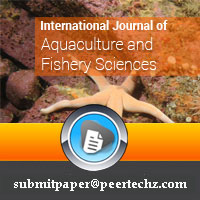
Article Alerts
Subscribe to our articles alerts and stay tuned.
 This work is licensed under a Creative Commons Attribution 4.0 International License.
This work is licensed under a Creative Commons Attribution 4.0 International License.
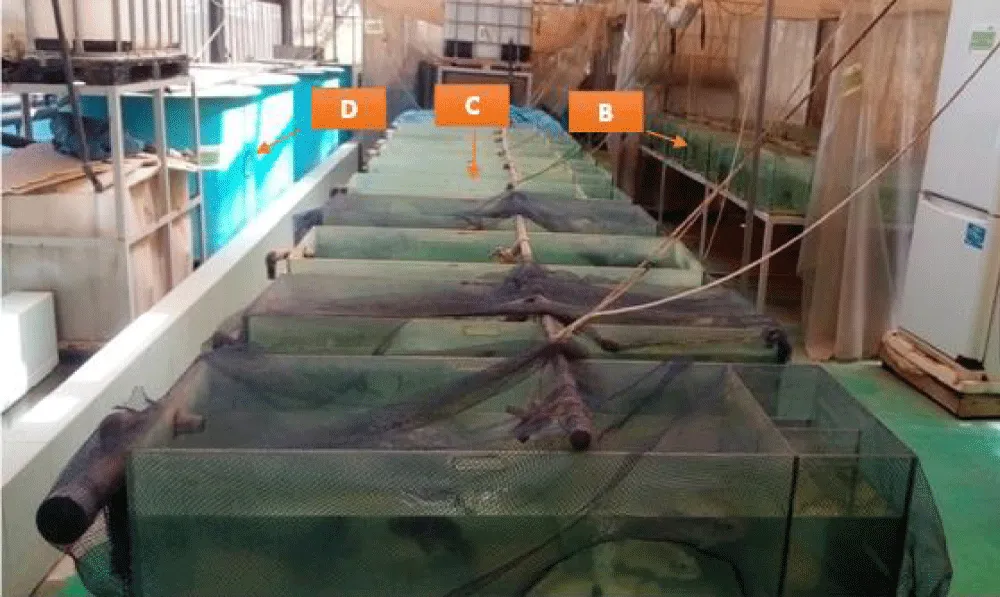
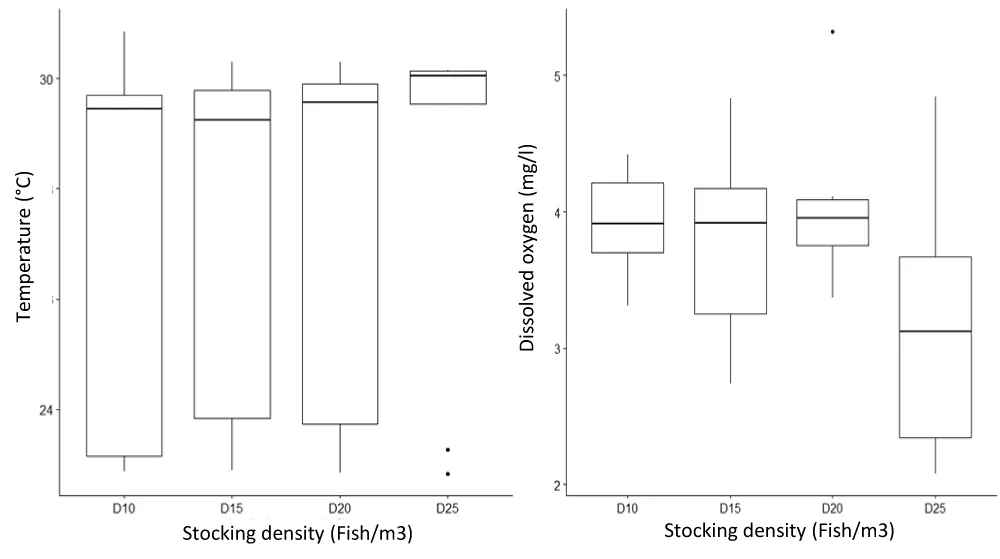
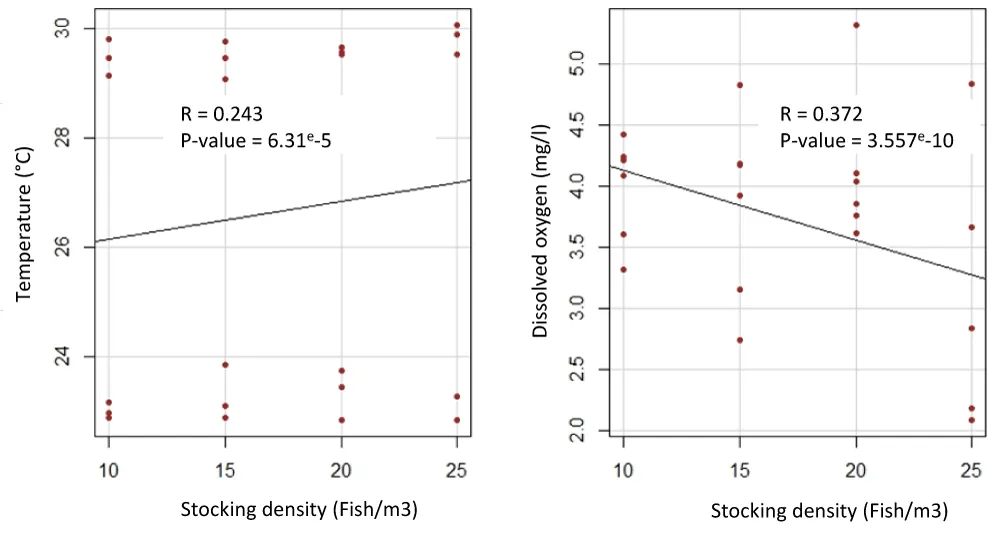
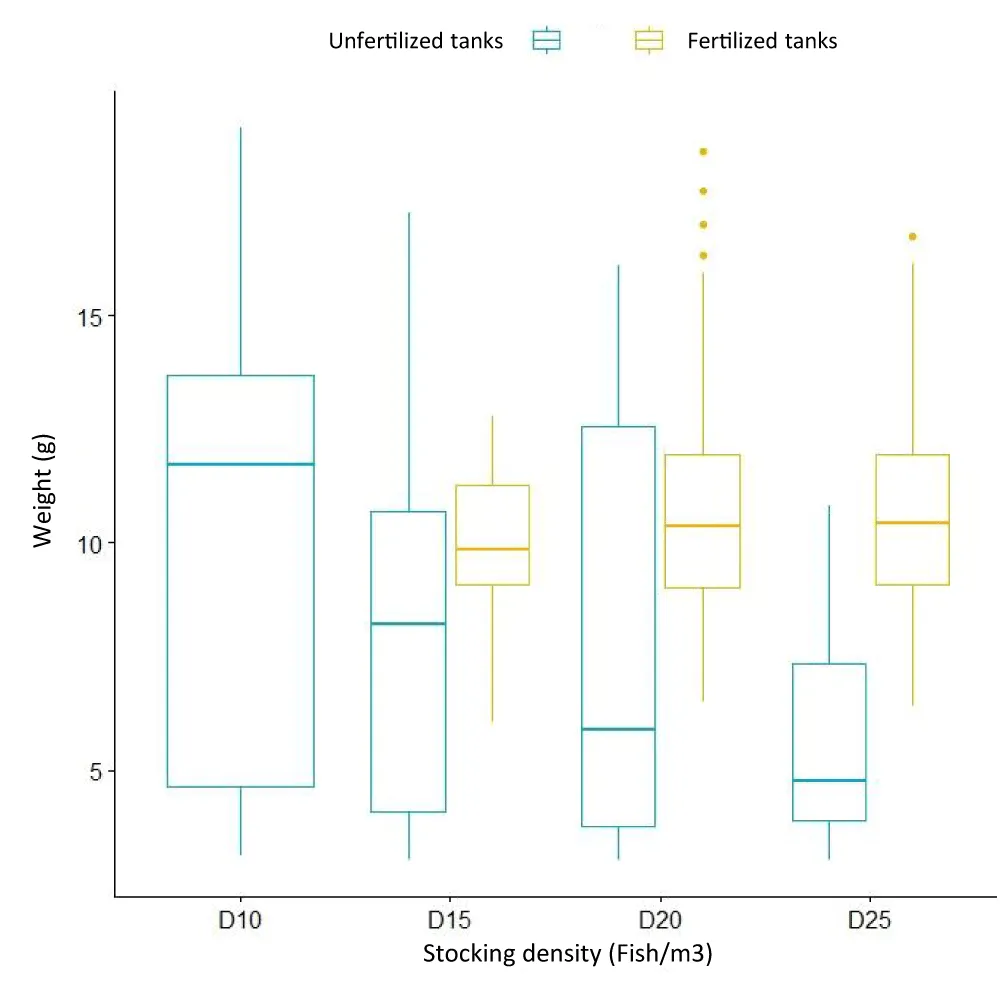
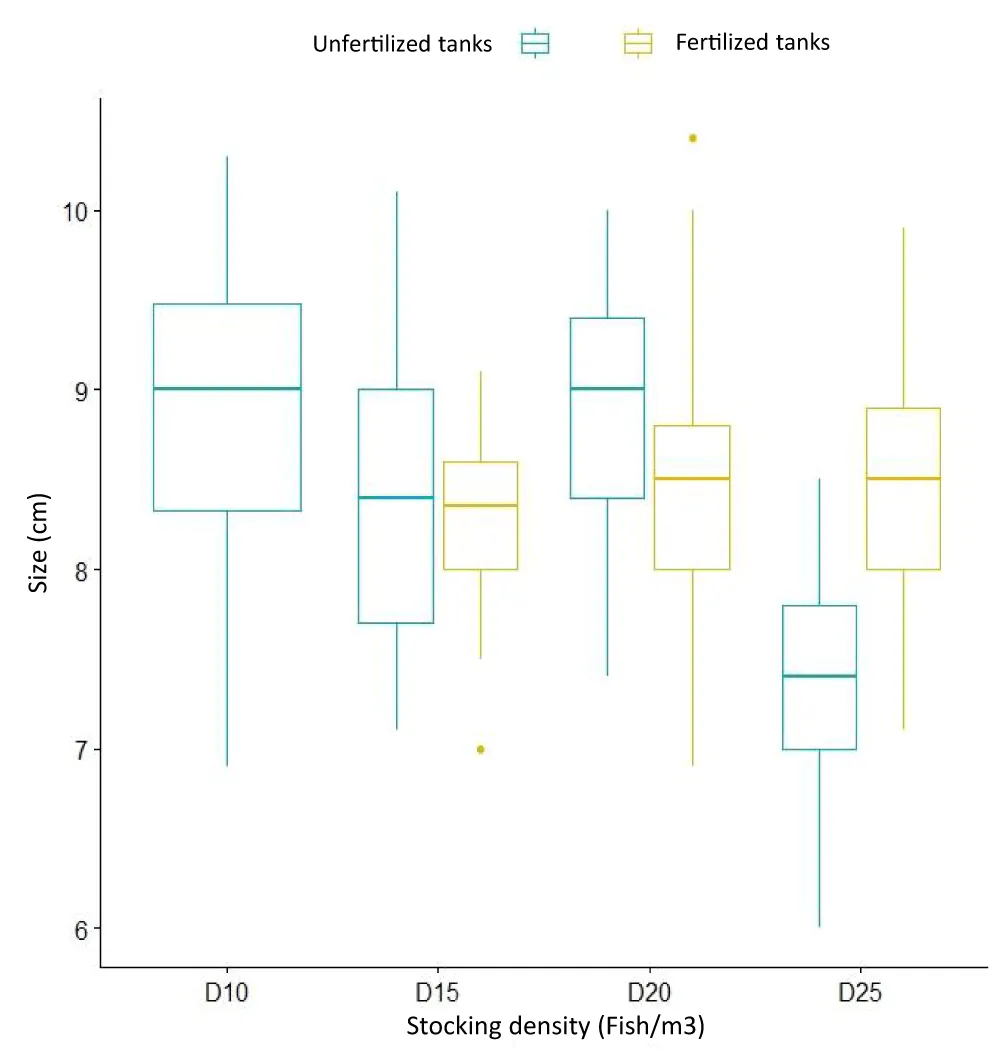
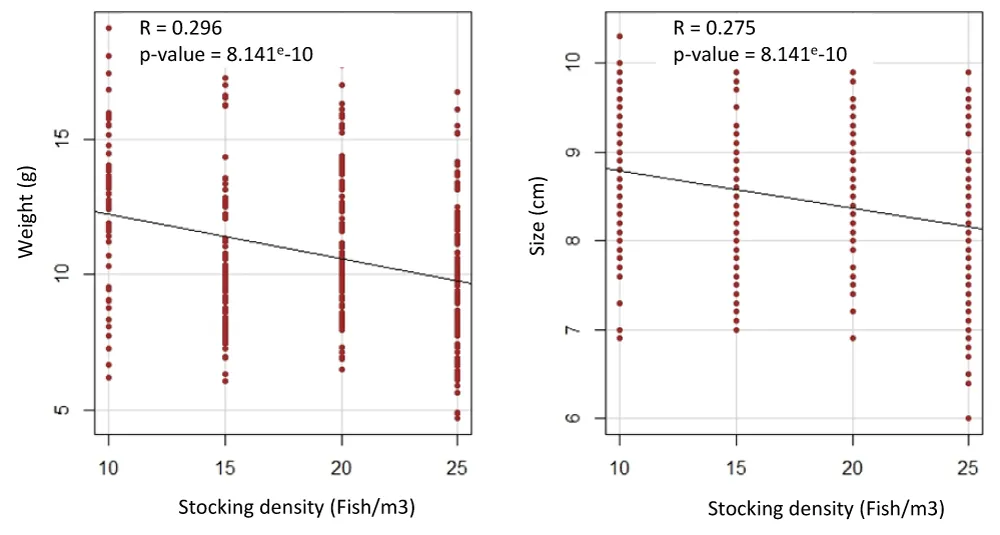
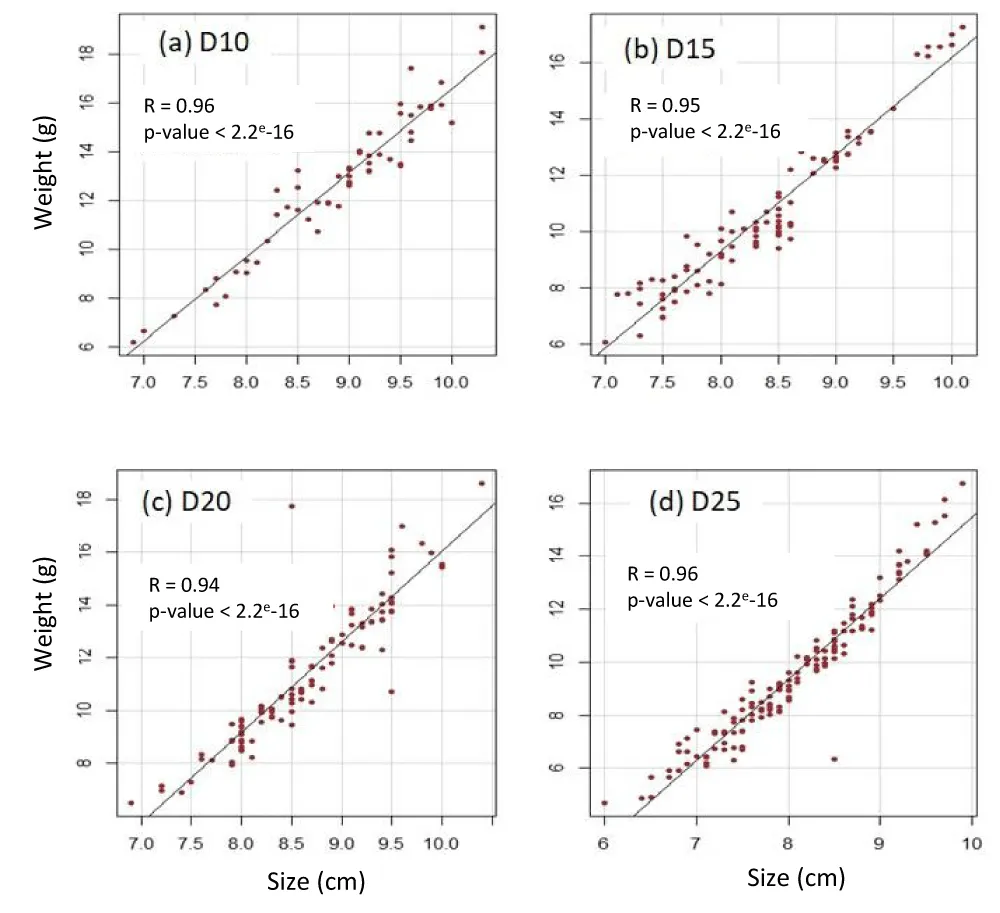
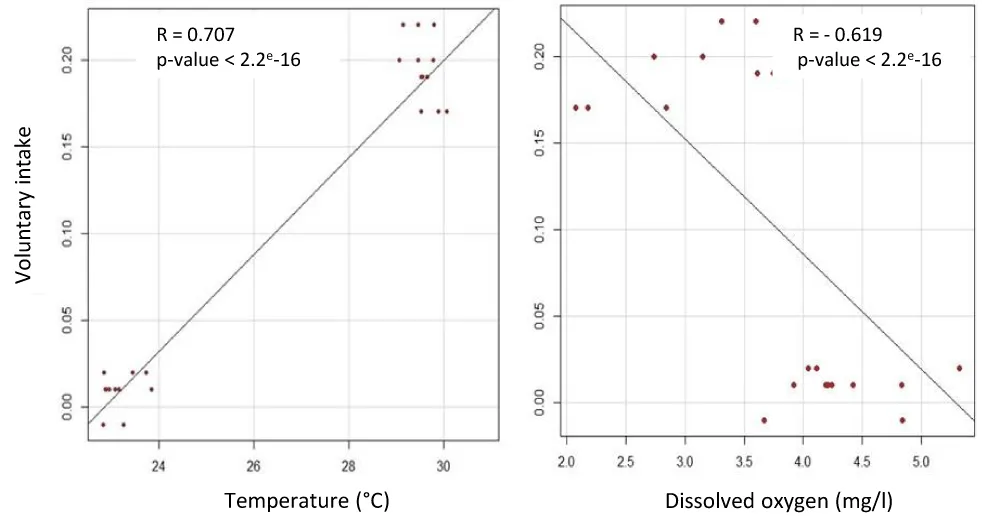

 Save to Mendeley
Save to Mendeley
